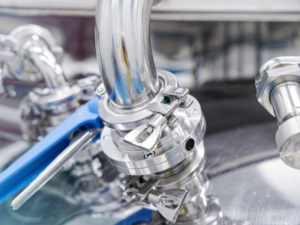As the third most abundant element in the universe, oxygen is used for combustion in processes such as welding and steel making, for biological activity including medical applications, wastewater countermeasures and sewage treatment systems. Oxygen is a high energy gas that readily oxidizes other materials and alone is not flammable but can be flammable when it reacts with other materials. Systems with higher oxygen levels will ignite at lower temperatures and have more powerful combustion. Substances that would not normally ignite in the air will burn and may explode in oxygen-rich environments.
Precision Cleaning
Precision cleaning is a process utilized in highly defined applications such as high purity processes and oxygen‑rich environments. Precision cleaning services are necessary for both safety and product purity in oxygen delivery for the medical, pharmaceutical and aerospace industries. Combustible contaminants must be removed from all surfaces that contact oxygen to prevent issues such as fire or explosion. Gauges, fittings, tubes, valves and filters are the types of parts cleaned using oxygen cleaning processes. Cleaning for oxygen service is not limited to just oxygen; it can be performed for other gasses such as nitrogen, argon, neon and krypton.
ASTM G93 specification is the guideline utilized in the Standard Practice for Cleaning Methods and Cleanliness Levels for Material and Equipment. It categorizes contaminants into 3 classifications: organics, inorganics, and particulates. Organics are VOC compounds and hydrocarbon-based greases and oils. Inorganics include nitrates, phosphates, water-based detergents and cutting oils, and acids or solvents. Particulates are lint, fibers, dust, weld slag and anything that could stimulate combustion or affect purity. Even the smallest particles can ignite if not properly removed.
The procedures document for the Cleaning of Equipment for Oxygen Service, CGA G-4.1, is produced and periodically updated for the compressed gas association for cleaning equipment used in the production, storage, distribution, and use of liquid and gaseous oxygen to reduce the risk of fire, explosion, and combustion. These procedures are required for all surfaces that encounter a gas or liquid in oxygen concentration greater than 23.5 percent.
The appropriate cleaning procedure should take into consideration the material and configuration of the parts, the type and amount of contamination, and the degree of cleanliness required. Cleaning methods are often used in combination to obtain the desired result and include mechanical, aqueous, solvent, ultrasonic and vapor degreasing processes.
Mechanical Precision Cleaning
Mechanical cleaning includes methods such as media blasting, wire brushing, scraping and grinding or the physical removal of contaminants such as scale, coatings, weld slag and other solids from the part. This pre-cleaning can typically remove up to 75% of the contaminants and is usually the first phase of preparation.
Aqueous Precision Cleaning
Aqueous cleaning uses hot water, steam, alkaline, acid, or detergent. Hot water and steam cleaning effectively remove water-soluble contaminants and are typically used with a detergent. Alkaline cleaning uses caustic type salt in water to produce a high alkalinity solution for eliminating hydrocarbon oils, greases and wax. Acid cleaning includes hydrochloric acid for removing scale, rust, and oxides; chromic and nitric acid for deoxidizing and passivating, which brighten and removes alkaline residues; and phosphoric acid to remove oxides and light rust and fluxes. Thoroughly rinsing the part with water is critical to remove any remaining cleaning agent residue that can be corrosive and potentially hazardous. DI (De-Ionized) water is preferred in all rinsing applications. The ultrasonic process uses high-frequency vibrations to create tiny bubbles in the cleaning solution. The high pressure bursts the bubbles releasing strong energy to displace contaminants from the component without causing damage to the part. The bubbles scrub strongly adhered and microscopic particles inside tubes, recessed areas, crevices and parts with difficult shapes and sizes.
Solvent Precision Cleaning
The three primary types of solvents for precision cleaning are oxygenated, hydrocarbon and halogenated solvents. Oxygenated solvents include alcohols, ethers, esters, glycol ethers, glycol ether esters and ketones. Solvents like alcohol evaporate completely, do not leave a residue and are frequently used to treat areas of concern during the inspection. Hydrocarbon solvents are petroleum-based with chemical structures that contain hydrogen and carbon atoms. The two main types of hydrocarbon solvents include aliphatic solvents such as gasoline, kerosene and hexane. Aromatic solvents often used as degreasing agents include benzene, xylene, and toluene. Halogenated solvents contain halogen atoms and because they are stable, non-flammable and evaporate quickly, were commonly used for precision cleaning. For environmental reasons, many halogenated solvents have been or are being phased out.
Vapor Degreasing
Vapor degreasing uses condensed solvent vapors on the parts in a vapor degreasing machine. The vapor degreaser has two tanks, a metal basket, and bands of cooling coils. One tank heats the solvent and the second tank collects the residual solvent. This method is effective for removing oil, grease wax, and other solvent-soluble particles from parts with inaccessible areas.
Machines and systems operating in an oxygen-enriched environment must be kept free of organic and inorganic contaminants. A failure to keep machines and their parts in strict compliance with the stringent oxygen cleaning requirements could lead to accidental ignition or combustion. Companies can lower their risk of an explosion due to risky particles by using thorough oxygen cleaning methods.
Contact AMF Technologies with any questions you may have.














